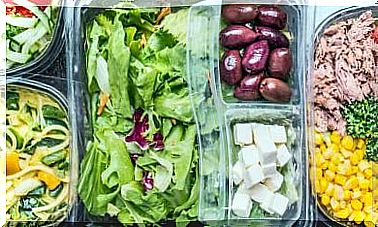The Health Benefits Of An Ayurvedic Diet

Ayurveda is one of the oldest traditional medical systems. It was developed on the Indian subcontinent. It is currently recognized as one of the formal health systems in the country and Ayurvedic diet is one of its pillars.
In Sanskrit, the word, ayurveda, means science or knowledge of life. It emphasizes health and disease prevention through lifestyle, massage, meditation and certain herbal remedies.
Read on to find out more about this way of life.
Ayurvedic diet
It is about more than eating healthy and is not a diet plan as such. The primary goal is to maintain a personal balance because one is what one eats.
Overall, there are three different types of dosha defined as a series of individual characteristics, and their basis is body type, personality, and dominant elements. Doshas are thus the key to optimal development.
The doshas are:
- Vata is quick-thinking, flexible and creative. They tend to be slim with a tendency to colds, digestive problems and difficulty focusing.
- The Pitta type is intelligent, hardworking, determined and medium built. They are susceptible to inflammation, have a good appetite and typically have no digestive problems.
- Kapha is calm and loving, strong and resilient and has a hard time losing weight. They are often constipated.

In addition to following the right type of diet for one’s dominant personality, the Ayurvedic diet is also based on a series of guidelines and routines to adhere to.
The most prominent for all types of people are:
- Eat three meals a day to allow you to complete the digestive cycle without interruption.
- Eat at least three hours before going to bed.
- Eat until you are full, not stuffed.
- Prioritize fresh, healthy foods.
- Include the six basic flavors in each meal.
- Eat consciously and in a relaxed environment.
Types of foods
Ayurveda has established guidelines for what, how and when to eat depending on one’s type of body and dominant dosha. There are detailed recommendations on the types of foods one should include in his diet, based on Vata, Pitta and Kapha.
Vata
These individuals need a nutritious diet consisting of prepared dishes at a warm temperature and mild spices. They need to maintain a regular schedule and their diet should include the following:
- Oatmeal and rice.
- Eggs, chicken and fish.
- Fermented dairy products.
- Legumes in limited quantities.
- Sweet, ripe and juicy fruits.
- Soaked almonds, walnuts and seeds in general.
- Sesame oil.
- Turmeric, cumin, coriander and ginger as spices.
They should limit their intake of:
- Red meat.
- Hard cheeses.
- Astringent dried fruits such as blueberries, apples and pomegranate.
- Raw vegetables and mushrooms.
Pitta
Cold slightly spicy dishes that are sweet, refreshing and bitter are best for this type of person. A vegetarian diet is a good solution for them and they should include the following in their diet:
- Barley, rice, oats and wheat.
- Chicken and turkey as sources of animal protein.
- Milk, ghee, butter and unsalted cheese.
- Legumes in small quantities (the best are black lentils, chickpeas and mung beans).
- Sweet fruits such as apples, blueberries and dates.
- Salad and raw vegetables.
- Sunflower and pumpkin seeds (once in a while).
- Cardamom, cinnamon, fennel and turmeric.
Pitta personality should avoid the following:
- Products of animal origin, in particular shellfish and eggs.
- Red and yellow lenses.
- Sour fruits and vegetables such as tomatoes, radishes, peppers, raw onions and garlic.
- Most grains and nuts because they are fatty.
- Strong spices.
Kapha
The most recommended diet for this dosha is one where strong, light and dry foods dominate. Bitter, astringent and strong spices also have a preference. These are thus the best types of food for them:
- Buckwheat and millet.
- Baked and grilled chicken, rabbit and seafood.
- Ghee and goat milk.
- Red lentils, black and mung beans.
- Mango, peach, apricot and pear.
- Vegetables that grow above the ground, especially green leafy vegetables such as spinach, beetroot and cabbage.
- Pumpkin and sunflower seeds in small quantities.
- Most spices: Garlic and ginger in particular.
This dosha should also avoid the following:
- Sweet potatoes, oats and wheat.
- Any type of dairy product and fat, insert fried foods.
- Very sweet and sour fruits.
- Root vegetables such as turnips, beets and radishes.
- Seeds and nuts in general.
- All sweeteners and salt.

Pros and cons of an Ayurvedic diet
The set of routines and types of foods that are part of an Ayurvedic diet focus on improving overall health. These are thus some of its strengths and advantages:
- First, it promotes a healthy lifestyle, which includes simple foods.
- Plant-based foods dominate and have many positive effects on disease prevention.
- It also promotes conscious eating.
- It is also a lifestyle.
- It can balance body weight through proper digestion, a better lipid profile and a lower risk of chronic diseases.
However, there are some things to consider before changing your lifestyle:
- Ayurveda is a lifestyle, not a diet, so it’s not just about food: you have to follow it as a whole.
- It can be difficult to find some products where you live and get used to their taste.
- Lastly, it requires dedication to change the way you cook and eat food.
Final recommendations for an Ayurvedic diet
You should talk to a Ayurveda specialist before making any major changes to your current diet and lifestyle. This is because they need to determine one’s dosha and establish any existing or possible imbalances that need to be addressed.
Good planning is the key when it comes to sticking to this plan. Everyone who follows it must thus dedicate a good amount of time and adapt to new habits and tastes.









